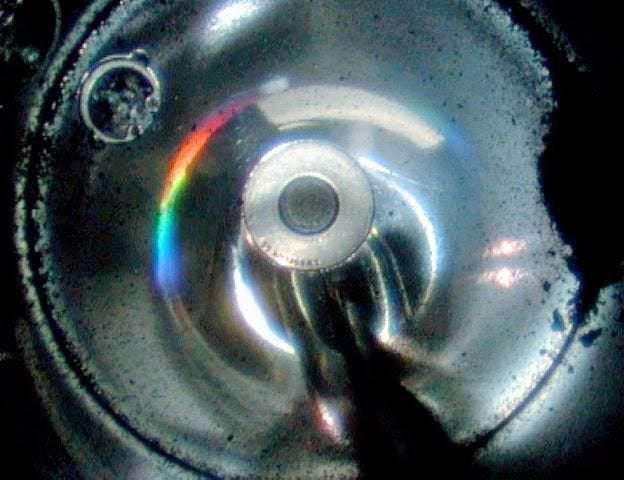An image looking inside the capsule, with some material from Ryugu clearly visible around the edge. JAXA
The Japanese space agency (JAXA) says it has begun opening the capsule returned to Earth by its historic Hayabusa2 mission – and has confirmed asteroid samples are inside.
Today, Monday, December 14, the capsule was opened for the first time since it touched down in the Australian outback on December 6 following its journey through space.
On board, scientists were hoping to find pieces of asteroid Ryugu, collected millions of kilometers from Earth – and now JAXA has confirmed the mission was successful.
“A black granular sample believed to be derived from the asteroid Ryugu was confirmed inside the sample container,” JAXA said in a short statement.
“This is thought to be the particles attached to the entrance of the sample catcher (the container in which the sample is stored).”
The entire capsule itself has yet to be opened, meaning there are likely more samples of the asteroid waiting inside.
But just confirming any samples at all were collected is fantastic news, as JAXA wasn’t sure how successful the sample capture had been.
Scientists will now spend years studying the sample, hoping to learn more about Ryugu’s origins and the origins of life on Earth too.
The trail of the capsule seen as it re-entered our atmosphere. AFP via Getty Images
Hayabusa2 was launched in 2014 on a mission to collect samples from Ryugu – Japan’s second attempt at retrieving material from an asteroid since the mostly successful Hayabusa1 in 2010.
Another mission, NASA's OSIRIS-REx, is also scheduled to return material from another asteroid, Bennu, in 2023.
Following a four-year journey, the spacecraft arrived at Ryugu in June 2018. It then deployed multiple landers onto the surface, before attempting to touch down itself and scoop up material.
It did so twice, once in February 2019 and again in July 2019, by firing a projectile into the surface and collecting material up a long sampler arm into the capsule container.
The second event was particularly notable, because the spacecraft had previously blasted a crater in the asteroid to expose pristine subsurface material for the collection attempt.
The spacecraft twice collected material from Ryugu's surface. ASSOCIATED PRESS
This material should date back to the dawn of the Solar System, potentially revealing if asteroids like Ryugu could have delivered the building blocks of life to Earth.
Scientists are also interested to know if asteroids like Ryugu contain a lot of water, as well as whether they contain mysterious seed-like rocks called chondrules.
The spacecraft, however, had no way of knowing if its two attempts at collecting a sample had been successful.
Scientists were only expecting to collect about a gram of material from the asteroid, but had to wait until Hayabusa2’s return to know how much – if any – sample was on board.
The Hayabusa2 spacecraft was roughly the size of a small car. ASSOCIATED PRESS
After leaving the asteroid in November 2019, Hayabusa2 finally returned back to Earth in December 2020.
Here it released the sample capsule, which re-entered our atmosphere on December 6 and touched down in Australia, where it was collected by scientists.
Gas was sucked out of the capsule after touchdown, which could contain volatiles from the asteroid such as water that can be studied.
Two days later on December 8, the capsule was then taken to Japan’s Sagamihara Campus in Sagamihara, Kanagawa Prefecture, where scientists have now begun the process of opening it.
The capsule container itself was only as big as a toaster. ASSOCIATED PRESS
Hayabusa2, meanwhile, continued back into space on an extended mission to explore the smallest asteroid ever visited by a spacecraft, no bigger than a blue whale.
But the main part of the mission was always returning the sample to Earth. And now that the presence of a sample in the capsule has been confirmed, the exciting analysis of the sample can soon begin.
“We will continue to open the sample catcher in the sample container, and the curation and initial analysis team will take out the sample and analyze it,” JAXA said in its statement.
And who knows what secrets lie in wait from this fascinating mission.

Kenji_4 on December 14th, 2020 at 15:10 UTC »
This article is beyond confusing. Title says the capsule was opened. It then says it is in the process of being opened. It then follows that by saying the particles revealed were just on the sample collector and it is hopeful that there is more in the capsule.
Sooo... The capsule isn't actually opened, it's just an outer shell or seal that was opened, and while that means there's most certainly stuff inside, they haven't actually even opened it yet contradicting their own headline.
PancakeZombie on December 14th, 2020 at 14:59 UTC »
Would be weird if they found samples from a different asteroid.
Yrouel86 on December 14th, 2020 at 14:26 UTC »
By the title I pictured an old wise man in the lab, Mr. Miyagi style, staring at the opened capsule for a while after which solemnly proclaiming "yep it's rocks"
Jokes aside I guess they had to confirm the presence of samples because they weren't sure to have it sealed before they escaped?